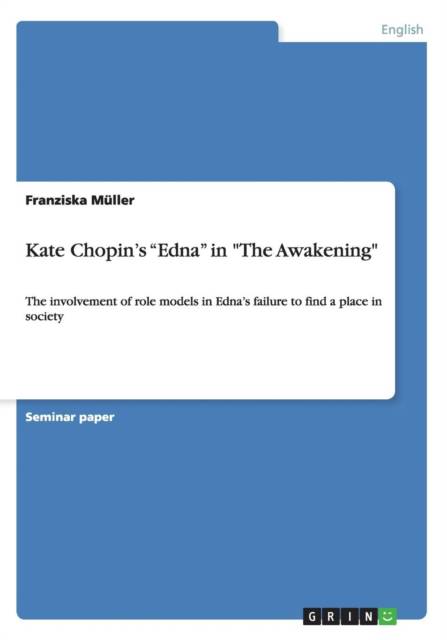
- Afhalen na 1 uur in een winkel met voorraad
- Gratis thuislevering in België vanaf € 30
- Ruim aanbod met 7 miljoen producten
- Afhalen na 1 uur in een winkel met voorraad
- Gratis thuislevering in België vanaf € 30
- Ruim aanbod met 7 miljoen producten
Zoeken
Kate Chopin's "Edna" in "The Awakening"
The involvement of role models in Edna's failure to find a place in society
Franziska Müller
Paperback | Engels
€ 25,95
+ 51 punten
Omschrijving
Seminar paper from the year 2012 in the subject English Language and Literature Studies - Literature, grade: 1,7, University of Heidelberg (Anglistisches Seminar), language: English, abstract: 1. Introduction Kate Chopin‟s the Awakening and especially its ending has been interpreted primarily in two different ways: There are those who believe that the ending, Edna‟s suicide, is Edna‟s final awakening (among them inter alia Rosowski, cf. "The Novel of Awakening." p.47) and there are those who argue that the ending is Edna‟s final realization of her failure to find a place in society (for example Lattin, cf. "Childbirth and Motherhood." p.44; Solomon cf. "Characters as Foils to Edna." p.119). But beyond these contrasting angles of interpretation, there is one common belief: The Awakening is Edna‟s struggle to find her own identity, her genuine place in society or, in short, herself: One of these days [...] I‟m going to pull myself together for a while and think try to determine what character of a woman I am; for, candidly, I don‟t know. By all the codes which I am acquainted with, I am a devilishly wicked specimen of the sex. But some way I can‟t convince myself that I am. I must think about it. (p.103) As the figures of Adèle Ratignolle and Mlle. Reisz show, it is, after all, possible for women to find an identity of their own. Patricia Hopkins Lattin and Deborah E. Parker have argued that these two women serve as role models for Edna. But both Lattin and Parker fail to give a role model-based explanation of Edna‟s failure to find her place in society. The question that shall be examined in the following is therefore the contribution of Edna‟s role models to her failure. It shall be analyzed why Edna, unlike Adèle and Mlle. Reisz, does not succeed in finding her place in society, and why she also does not succeed to model herself on Adèle or Reisz. In order to answer this question, especially the differences between Edna and each of her role-models shall be examined
Specificaties
Betrokkenen
- Auteur(s):
- Uitgeverij:
Inhoud
- Aantal bladzijden:
- 20
- Taal:
- Engels
Eigenschappen
- Productcode (EAN):
- 9783656237464
- Verschijningsdatum:
- 21/07/2012
- Uitvoering:
- Paperback
- Formaat:
- Trade paperback (VS)
- Afmetingen:
- 178 mm x 254 mm
- Gewicht:
- 54 g

Alleen bij Standaard Boekhandel
+ 51 punten op je klantenkaart van Standaard Boekhandel
Beoordelingen
We publiceren alleen reviews die voldoen aan de voorwaarden voor reviews. Bekijk onze voorwaarden voor reviews.








